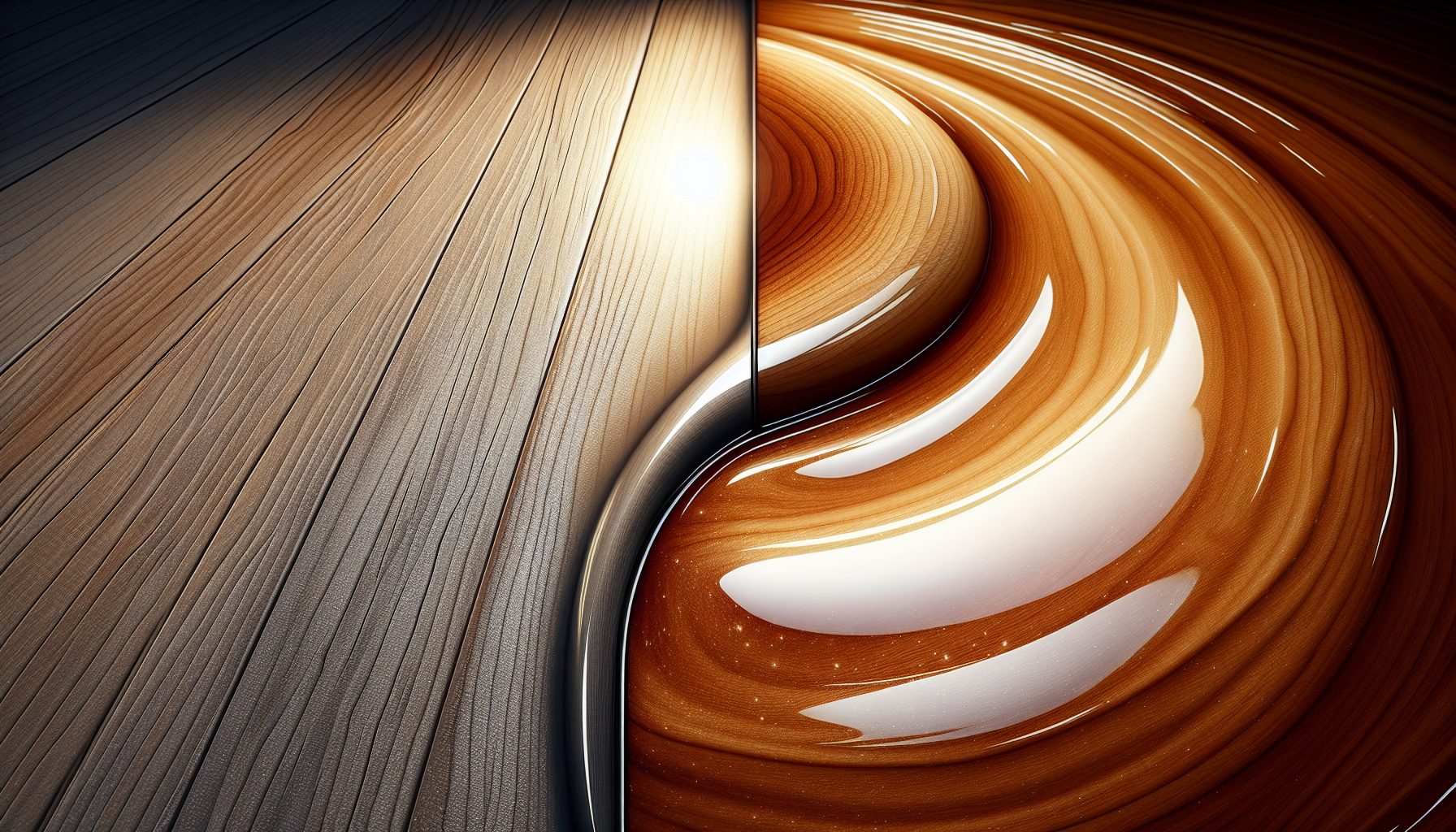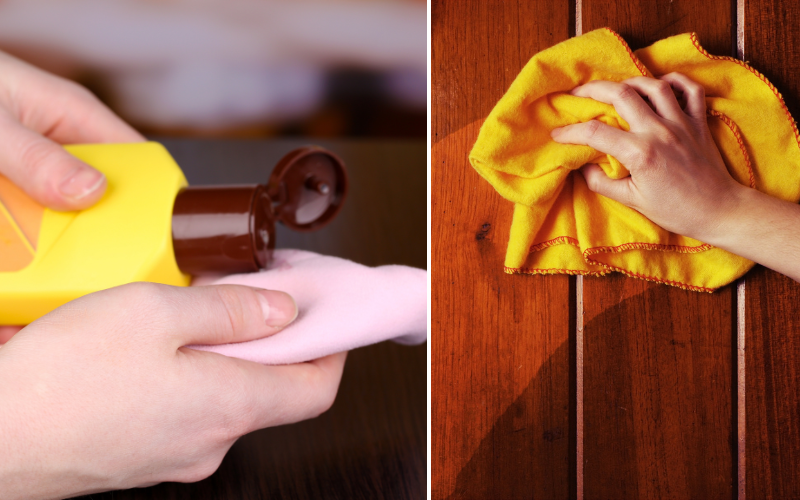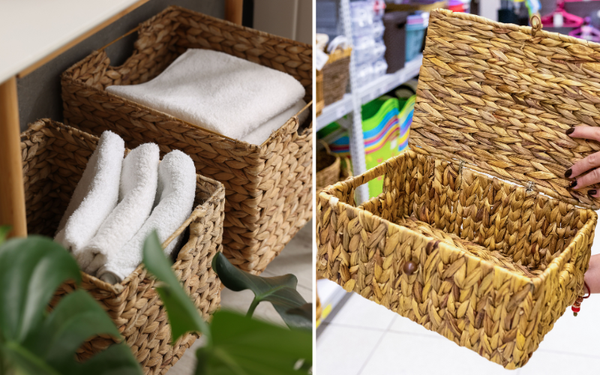Are you considering giving your wood furniture a fresh sheen but can’t decide what is the difference between wax and polish for wood? Here’s the deal: wood wax enhances the natural grain and offers a subtle, warming glow, ideal for antiques and fine furniture. In contrast, wood polish provides a sturdy layer of shine, suitable for modern finishes and surfaces in high-use areas. Let’s dive into the differences, ensuring you make the perfect choice for your treasured pieces.
Key Takeaways
- Wood wax and furniture polish serve different purposes; wax provides a protective seal and enhances natural grain, whereas polish offers a protective coating with a high shine.
- The application and maintenance of wax and polish differ; wax requires regular re-waxing and buffing for maintenance, while polish generally needs less frequent touch-ups.
- Environmental impact and personal preference play significant roles in choosing between wax and polish; natural waxes offer a more eco-friendly option, while polish is suited for modern finishes and high-traffic areas.
Unveiling the Essentials: Wax vs. Polish for Wooden Surfaces

Wax and polish, two stalwarts of wood care, serve different, yet equally important purposes. Wood wax, for instance, is primarily used to seal and protect the wood, reducing damage from stains, spills, abrasions, humidity, and moisture. It enhances the beauty of the wood grain, providing a rich, warm glow that is hard to replicate with other treatments. On the other hand, furniture polish is designed to enhance the durability and resistance of wood surfaces, providing a protective coating that can endure heavy usage.
Choosing between wax and polish for your wood projects involves considering their advantages, disadvantages, and the specific needs of your project. While both can be used on all types of wood, including oak, beech, and maple, their effects can vary based on the wood’s texture, the environment, and the desired finish. Hence, grasping the basic distinctions between wax and polish is key to making a well-informed choice that guarantees the durability and aesthetic appeal of your wooden surfaces.
Composition: Natural Waxes vs. Synthetic Polishes
One fundamental difference between wax and polish is their composition. Natural wood waxes, for instance, are typically composed of ingredients like beeswax and carnauba wax, sometimes coupled with essential oils like orange oil. These natural ingredients work in harmony to protect and nourish the wood, allowing it to breathe while providing a water-resistant surface. The variety of wood waxes available caters to different needs, from regular Wood Wax for a natural look to Clear Carnauba Wax for a durable sealing finish.
On the contrary, synthetic furniture polishes contain various chemicals designed to enhance the wood’s shine and protect it from damage. While they provide a high-gloss finish, they often lack the depth and warmth that natural waxes offer. Moreover, some of these chemicals can be harsh, potentially causing damage to the wood over time. Hence, when deciding between natural waxes and synthetic polishes, it’s important to think about more than just the aesthetic outcome, but also the potential long-term impacts on your wooden surfaces.
Application Techniques: From Soft Cloth to Buffing
The application techniques for wax and polish also differ significantly. Wood wax, for example, should be applied with a lint-free cloth to ensure a smooth application without leaving behind any residue. The process involves spreading a thin layer of wax over the wood surface, allowing it to dry, and then buffing it to achieve the desired sheen. The buffing process, performed with an open weave cotton cloth, helps achieve a consistent sheen without melting the wax.
Polish, on the other hand, is typically sprayed or wiped onto the wood surface, followed by buffing to enhance the shine. Unlike wax, polish doesn’t dry out, which means it can be buffed immediately after being applied. Nevertheless, the simple application process doesn’t guarantee less effort; obtaining a high-gloss finish with polish frequently requires several applications and meticulous buffing.
Finish Results: Satin Sheen vs. High Shine

The finish results of wax and polish are distinctly different. Applying wood wax enhances the natural beauty of the wood and provides a protective barrier against dust and stains. It also highlights interesting wood grain features, maintaining the piece’s natural look. Wax finishes give a unique look and tactile feel to wood, enhancing the perception of value, with the ability to be buffed to various sheen levels. To achieve a glossier finish with wax, a second coat can be applied to areas that require more coverage.
Polish, in contrast, creates a smooth, reflective surface. While it also protects the wood from dust and stains, its primary purpose is to enhance the shine of the wood surface. The result is a high-gloss finish that can make the wood look sleek and modern. However, this high shine can sometimes diminish the natural texture of the wood, making it appear less natural compared to a wax finish.
The Protective Qualities: Barrier and Durability Factors

While aesthetic appeal is significant, the protective properties of wax and polish hold equal importance. Both treatments offer a level of protection for wooden surfaces, but they do it in different ways. For instance, marine-grade finishes provide substantial protection against UV rays for outdoor wood exposed to the elements. On the other hand, indoor wooden furniture, which does not require UV ray protection, can benefit from polyurethane finishes for enhanced durability.
Yet, when comparing wood wax and furniture polish, the former is recognized for forming a more robust protective layer. Wax forms a thick barrier that shields the wood from moisture and abrasions, reducing the risk of damage over time.
Conversely, polish enhances the durability and resistance of the wood, providing a protective coating that makes the surface more resistant to damage and requires less frequent touch-ups.
Wax: A Protective Layer Against Wear and Tear
When it comes to providing a robust barrier against wear and tear, wax is a clear winner. Furniture wax creates a thick barrier that effectively shields wood from moisture and abrasions, better than polish. The application of high-quality wax polish followed by buffing on antique wood surfaces not only enhances their natural look but also establishes an additional layer of protection.
Products like Howard Products Feed-N-Wax Wood Polish & Conditioner, which contain carnauba wax and beeswax, are particularly recommended for antique wood to provide a protective coat and help maintain moisture levels within the wood. By forming a barrier over wood grain, beeswax polish application guards against the infiltration of dirt and grime, preserving the wood’s natural beauty and integrity.
Polish: Enhancing Durability and Resistance
While wax excels in protection, polish shines in enhancing durability and resistance. Furniture polish forms a barrier on the surface of the furniture, making it more resistant to moisture, stains, and scratches. Polish acts as a protective coating for wood, making it less susceptible to moisture and scratches, which translates to less frequent touch-ups than wax.
Furniture polish is designed to:
- Protect wood from typical damage such as abrasions and scratches
- Minimize dust adherence due to reduced friction on the wood surface
- Keep the wood looking new
- Serve a protective function
- Prevent deterioration and enhance the durability of the wood’s surface
Regularly polishing wood can help achieve these benefits.
Maintenance Matters: Regular Upkeep for Waxing and Polishing
Regardless of the quality of the wax or polish used, consistent maintenance is indispensable to retain the best appearance of your wooden surfaces. Waxed wood surfaces require reapplication of wax at least once every six months to maintain their protective qualities and sheen. Regular dusting with a microfiber cloth is also essential to keep waxed wood surfaces clean and clear.
On the other hand, furniture polish generally demands less frequent reapplication than wood wax, contributing to easier upkeep. However, occasional polishing is required to enhance its appearance and extend the protection of the surface. Regardless of the treatment chosen, remember that the longevity and beauty of your wooden surfaces largely depend on regular and appropriate maintenance.
For Wood Wax: Elbow Grease and Timely Re-waxing
Maintaining waxed wood surfaces requires some elbow grease and timely re-waxing. Here are the steps to follow:
- Buff the wood furniture regularly to preserve its sheen.
- Apply wax to the wood surface as needed to maintain its condition.
- Perform an annual maintenance, including a quick buff, to keep the wax finish in good shape.
By following these steps, you can ensure that your waxed wood surfaces stay looking their best.
Wood wax often necessitates a maintenance strategy that evolves over time. Here are some guidelines to follow:
- Initially, frequent applications of wood wax are needed, which decrease as the wax layers harden.
- It is essential to reapply wood wax regularly to maintain its protective qualities, typically on an annual basis.
- If buffing the surface no longer restores its shine, it is time to reapply the wax.
By following these guidelines, you can ensure wood protection and well-maintained wood surfaces, keeping the wood’s surface in its best condition.
Remember, however, to avoid excessive buildup of furniture wax, which can dull the wood’s natural shine.
For Furniture Polish: Simple Wipe Down and Less Frequent Touch-ups
Maintaining polished wood surfaces is comparatively straightforward. It typically involves a simple weekly wipe down with a dry cloth. Furniture polish generally demands less frequent reapplication than wood wax, contributing to easier upkeep. The ease of cleaning and lower frequency of touch-ups make furniture polish a convenient option for maintaining wooden surfaces.
However, it’s important to remember that while polish requires less frequent touch-ups, it’s not a set-and-forget solution. Regular polishing is still necessary to keep the wood looking its best and to extend the protection of the surface.
Suitability and Preferences: Choosing the Right Treatment for Your Wood Furniture
Choosing the right treatment for your wood furniture is not a one-size-fits-all affair. It depends on various factors including the type of wood, its usage, and your desired appearance. For instance, some treatments like Roxil Beeswax Wood Polish are suitable for a variety of wooden furniture types, including modern or antique pieces, as well as softwoods and hardwoods. The suitability of such treatments is not limited by the usage frequency of the furniture, serving well for both heavily used surfaces and those that are primarily decorative.
Hence, when selecting a treatment for your wood furniture, it’s vital to take into account the wood’s characteristics, usage frequency, and your personal tastes. After all, the goal is not only to protect and preserve your wooden surfaces but also to enhance their beauty and appeal.
When to Use Wood Wax: Bare Wood and Antique Preservation
Wood wax is particularly beneficial for untreated or bare wood, as it enhances the natural look while adding protection. Some benefits of using wood wax include:
- Enhancing the natural look of the wood
- Adding a protective layer
- Conditioning wooden surfaces
- Ideal for antiques as it does not damage them even with repeated applications
- Provides a modest sheen and adequate coverage for untreated wood
Furthermore, wood wax can be applied over other finishes, adding an extra layer of protection and enhancing the wood’s sheen. Therefore, if you’re dealing with bare wood, antiques, or even want to enhance the look of other finishes, wood wax could be the ideal choice for you.
When to Opt for Furniture Polish: Modern Finishes and Heavy Use Areas
Furniture polish, on the other hand, is suitable for modern finished surfaces where increased durability is required for areas of frequent use. Products like Guardsman’s Anytime Clean & Polish are ideal for modern, finished, and sealed wood furniture, especially in high-traffic areas. These offer a formula that cleans and polishes while also providing UV protection to prevent discoloration and fading.
If you’re dealing with modern furnishings or heavy-use areas, furniture polish may offer the durability and protection you need. It can help maintain the sleek, high-gloss look that is often associated with modern furniture, making it a suitable choice for contemporary settings.
Environmental Impact: Wax and Polish in the Eco-Friendly Spotlight
In a time where environmental sustainability is a primary concern, the ecological footprint of wax and polish cannot be ignored. Traditional wood waxes and furniture polishes may contain high levels of volatile organic compounds (VOCs) that contribute to environmental pollution and poor indoor air quality. Furniture polish often includes synthetic chemicals that can be harmful to the environment, especially when they enter waterways after being used on furniture.
However, the good news is that there are environmentally friendly options available in the market. Wood waxes that are made with natural oils, such as linseed or tung oil, offer a more environmentally friendly option as they tend to be biodegradable and emit lower amounts of VOCs.
The Green Side of Wood Wax: Low VOCs and Natural Ingredients
When it comes to eco-friendliness, natural waxes like soft wax, beeswax, and carnauba wax, along with eco-friendly oils such as linseed and walnut oil, are key ingredients that make certain wood waxes environmentally benign and sustainable. These eco-friendly wood finishes are often water-based and designed to have low or zero VOC levels, reducing their environmental impact and improving indoor air quality.
Moreover, wood wax is a health-conscious choice for protecting wooden surfaces, as it can be safely used on floors, decor, and even items involved in food preparation, without leaving harmful residues. Thus, if you’re environmentally conscious, natural waxes could be the perfect solution for your wood care needs.
The Chemical Question: Evaluating Polishes and Their Ingredients
Conventional wood finishes, including varnishes and stains, tend to contain harsh chemicals and volatile organic compounds which can degrade air quality and contribute to smog and ozone depletion. Nevertheless, eco-friendly substitutes to these harmful synthetic polishes are readily available.
Commercial products made from mineral oil and citrus oil serve as alternatives to synthetic polishes with harsh chemicals. Therefore, when choosing a polish, it’s important to consider not just its effect on your furniture but also its impact on the environment. Opt for products that utilize fewer harsh chemicals, aligning with eco-friendly practices.
Tailoring to Texture: How Wax and Polish Affect Wood Grain and Surface
Both wax and polish have unique effects on the texture of wood, which can significantly influence the overall look and feel of your wooden surfaces. Wood wax, for instance, sits on the surface of wood, maintaining the natural look and enhancing the visibility of unique grain patterns. It brings the wood grain to life, providing a tactile surface that adds depth and character to the wood.
Polishing wood, on the other hand, results in a smooth finish that may diminish the natural texture by filling in pores and leveling the grain, offering a less natural tactile experience. Hence, when deciding between wax and polish, it’s important to reflect on the preferred texture and appearance of your wooden surfaces.
Preserving Wood Grain with Wax
Wood wax is known for its ability to:
- Enhance the natural wood grain
- Create a smooth feel on furniture
- Highlight the natural wood grain features
- Enhance the overall visual and tactile quality of the wood
- Contribute to a more natural feel on the surface, offering an experience that stays true to the essence of the wood itself.
Wood wax not only brings out the beauty of wood grains but also provides a durable protective coating that does not yellow, ensuring the wood’s natural look is preserved over time. Hence, for those who appreciate the natural grain and texture of wood, using paste wax could be the ideal choice.
Achieving a Smooth Finish with Polish
On the other hand, if you prefer a smooth, reflective surface, polishing is the way to go. Polishing wood with progressively finer abrasives followed by buffing can effectively fill in the pores, resulting in a surface that is both smooth and reflective, albeit with a diminished natural wood grain texture.
While this high-gloss finish can make the wood look sleek and modern, it does come at the cost of the wood’s natural texture. So, if you’re aiming for a smooth, high-gloss finish, polish could be your best bet.
Summary
In conclusion, both wax and polish have their unique benefits and shortcomings, and the choice between the two largely depends on your specific needs and preferences. Wax is ideal for preserving the natural look and texture of wood, while polish offers a high-gloss finish and enhanced durability. However, both treatments require regular maintenance to keep your wooden surfaces looking their best. Moreover, considering the environmental impact of your choice is crucial in today’s eco-conscious world. Ultimately, whether you choose wax or polish, remember that proper care and maintenance are key to preserving the beauty and longevity of your wooden surfaces.
Frequently Asked Questions
What are the primary purposes of wood wax and furniture polish?
Wood wax is used to seal and protect wood from stains, spills, abrasions, and moisture, while furniture polish enhances the durability and resistance of wood surfaces. Both products serve to maintain and prolong the life of wood furniture.
What is the difference between natural waxes and synthetic polishes?
Natural waxes like beeswax and carnauba wax provide a more organic approach to wood care, while synthetic polishes use chemicals for enhanced shine and protection. Consider the impact on your wood's longevity and the environment when choosing between the two options.
How often should I reapply wax or polish on my wooden surfaces?
You should reapply wax on wooden surfaces at least once every six months, while furniture polish requires less frequent reapplication. Regular maintenance will keep your wooden surfaces looking their best.
When should I use wood wax or furniture polish?
Use wood wax for untreated or bare wood to enhance its natural look and provide protection. For modern finished surfaces requiring increased durability, opt for furniture polish.
How does wax and polish affect the texture of wood?
Wax enhances the natural wood grain and provides a tactile surface, while polishing results in a smooth finish that may diminish the natural texture by filling in pores and leveling the grain. Consider these effects when choosing how to finish your wood project.
You Might Also Like...










